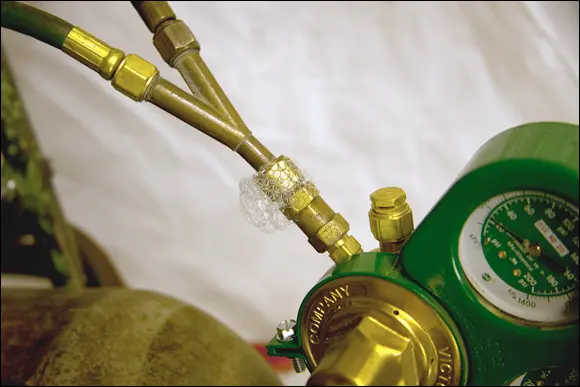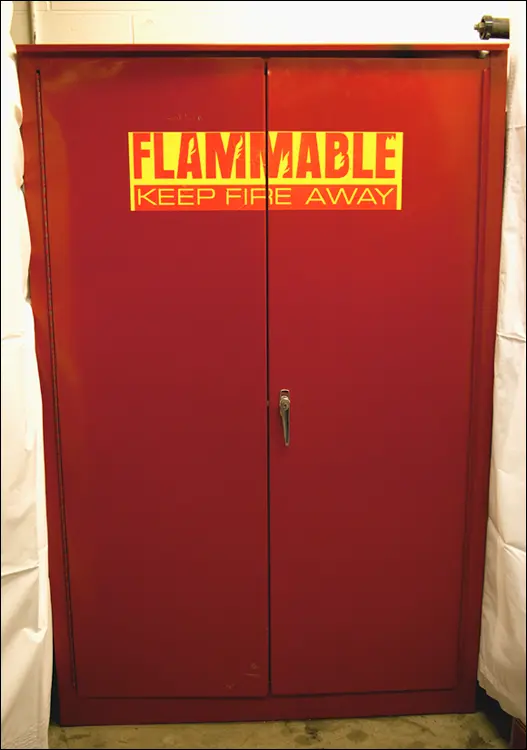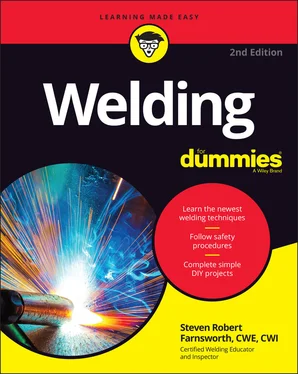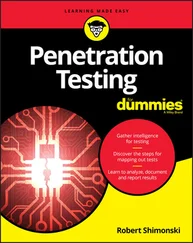1 Mix one teaspoon of dish soap in a spray bottle full of water.
2 Spray the mixture onto any area of a pressurized container that is likely to have a leak.Fittings and valves are usually the most likely sources of a leak.
3 Look and listen closely for bubbles.If you see bubbles or hear a bubbling noise, that probably means you have a leak. If the bubbles are popping up near a fitting, use a wrench to tighten up the fitting. Then reapply the soapy water and check again for bubbles. If you see bubbles on or near a valve, it may be time to replace the valve.
 If you’re using any oxyacetylene equipment (see Chapters 11, 12, and 13), you know when you have a leak if you smell garlic. Manufacturers now add a compound to the acetylene that makes it smell like garlic; if you get a waft of garlic smell and think you may have a leak, use the soapy water method I describe in this section to find out where the leak is coming from. (Of course, the garlic smell may also be the result of the pizza you had for lunch, in which case you may just want to grab a stick of gum.)
If you’re using any oxyacetylene equipment (see Chapters 11, 12, and 13), you know when you have a leak if you smell garlic. Manufacturers now add a compound to the acetylene that makes it smell like garlic; if you get a waft of garlic smell and think you may have a leak, use the soapy water method I describe in this section to find out where the leak is coming from. (Of course, the garlic smell may also be the result of the pizza you had for lunch, in which case you may just want to grab a stick of gum.)
 White thread seal tape can be useful for making sure that fittings and valves don’t leak, but be sure you never use the tape on brass fittings because brass fittings seal themselves.
White thread seal tape can be useful for making sure that fittings and valves don’t leak, but be sure you never use the tape on brass fittings because brass fittings seal themselves.
 Hoses are also common sources of leaks, so make sure to inspect your hoses frequently for nicks and burned sections. And please don’t try to fix your hoses with tape! Tape fixes aren’t reliable, and they don’t last very long. Figure 3-4 shows you what a leaking oxygen hose looks like.
Hoses are also common sources of leaks, so make sure to inspect your hoses frequently for nicks and burned sections. And please don’t try to fix your hoses with tape! Tape fixes aren’t reliable, and they don’t last very long. Figure 3-4 shows you what a leaking oxygen hose looks like.
Getting the ventilation right
Welding produces byproducts, and while you’re welding you can be exposed to a number of dangerous gases. These gases are created when metals are heated above their melting points, when certain electrodes (with special coatings) are in use, and when you don’t scrape or clean certain materials (paint, for example) off a section of metal before you weld it.

FIGURE 3-4:An example of a leaking oxygen hose.
If you want to stay healthy, you certainly don’t want to inhale those gases, so make sure your welding area is properly ventilated before you begin any welding operation. You can use natural ventilation if you have windows, doors, or garage doors in your welding shop that you can open safely to allow a breeze in. You can also utilize forced air movement with fans and blowers. For detailed information on how to ensure a suitable level of ventilation in your welding workspace, check out the welding-specific information provided on the Occupational Safety and Health Administration (OSHA) website at www.osha.gov/SLTC/weldingcuttingbrazing .
 Proper ventilation is always important, but it’s completely critical when you’re welding metals that create particularly noxious, dangerous fumes. These metals include (but aren’t limited to) lead, zinc, and cadmium. Be sure to read your MSDS before using any new material.
Proper ventilation is always important, but it’s completely critical when you’re welding metals that create particularly noxious, dangerous fumes. These metals include (but aren’t limited to) lead, zinc, and cadmium. Be sure to read your MSDS before using any new material.
Storing flammable liquids and gases
You may need to keep several flammable liquids and gases on hand in your welding shop, including acetylene, propane, and natural gas. You need to treat these materials with a great deal of care and respect because they can cause a huge amount of injury and damage in no time at all.
Store all flammable liquids in sealed containers and keep the containers in a flammable liquids locker like the one depicted in Figure 3-5. These lockers are made of metal and have a door that closes securely. You can buy a flammable liquids locker at your welding supply store or even a home improvement warehouse. As you can imagine, you don’t want to put the locker anywhere in your shop or welding area with a source of heat nearby.

FIGURE 3-5:A common flammable liquids storage locker, appropriately labeled.
 A few common flammable welding gases (such as the acetylene, propane, and natural gas I mention earlier in the section) are compressed so that a large amount of gas can be put into a cylinder for controlled use. If you have these cylinders in your welding shop, be sure to store them far away from any heat source. Oxygen gas is also very dangerous when pressurized, so treat it with the same respect you would any other potentially hazardous gas.
A few common flammable welding gases (such as the acetylene, propane, and natural gas I mention earlier in the section) are compressed so that a large amount of gas can be put into a cylinder for controlled use. If you have these cylinders in your welding shop, be sure to store them far away from any heat source. Oxygen gas is also very dangerous when pressurized, so treat it with the same respect you would any other potentially hazardous gas.
Knowing your surroundings
You can prevent many different types of safety hazards in your welding shop simply by being aware of your surroundings and reacting quickly when something goes awry. When you’re working on a weld, you can easily get really focused and lose track of what’s going on around you, so you have to make a real effort to stay aware of your environment.
Pay close attention to any unusual smells or sounds. If you hear or smell something strange, check it out immediately — it may very well be a fire or something starting to catch fire. When you take a break from welding, either for a few minutes or for the night, take some time to look around the area to make sure nothing is burning or smoldering.
 When you finish welding, double-check to make sure your welding equipment is turned off so that it doesn’t start a fire after you leave it unattended.
When you finish welding, double-check to make sure your welding equipment is turned off so that it doesn’t start a fire after you leave it unattended.
You should also take care to understand the materials you work with and give them the respect they deserve. Welding requires a number of harmful materials, and the short- and long-term effects of those items on your health can be severe. As I note throughout the chapter, always look at the MSDS for your materials so that you’re well informed of potential risks.
 Don’t weld or cut anywhere near an area that may contain explosive or flammable vapors.
Don’t weld or cut anywhere near an area that may contain explosive or flammable vapors.
Welding also creates quite a bit of waste material that can harm your health. Electrode stubs (the 2- to 3-inch pieces of stick welding electrode that you can’t use) and scrap metal are two of the top offenders. Keep those things in safe containers until you can take them to your local metal recycling center. Some of the flux and dust that you generate when welding can be considered hazardous waste; read the literature that comes with your electrodes to understand what you’re up against. If you’re dealing with hazardous waste, don’t just throw it in the trash, on the ground, or in the toilet. Instead, dispose of it by taking it to your area’s hazardous waste disposal facility.
Protecting yourself from electric shock
Читать дальше

 If you’re using any oxyacetylene equipment (see Chapters 11, 12, and 13), you know when you have a leak if you smell garlic. Manufacturers now add a compound to the acetylene that makes it smell like garlic; if you get a waft of garlic smell and think you may have a leak, use the soapy water method I describe in this section to find out where the leak is coming from. (Of course, the garlic smell may also be the result of the pizza you had for lunch, in which case you may just want to grab a stick of gum.)
If you’re using any oxyacetylene equipment (see Chapters 11, 12, and 13), you know when you have a leak if you smell garlic. Manufacturers now add a compound to the acetylene that makes it smell like garlic; if you get a waft of garlic smell and think you may have a leak, use the soapy water method I describe in this section to find out where the leak is coming from. (Of course, the garlic smell may also be the result of the pizza you had for lunch, in which case you may just want to grab a stick of gum.) White thread seal tape can be useful for making sure that fittings and valves don’t leak, but be sure you never use the tape on brass fittings because brass fittings seal themselves.
White thread seal tape can be useful for making sure that fittings and valves don’t leak, but be sure you never use the tape on brass fittings because brass fittings seal themselves.
 Proper ventilation is always important, but it’s completely critical when you’re welding metals that create particularly noxious, dangerous fumes. These metals include (but aren’t limited to) lead, zinc, and cadmium. Be sure to read your MSDS before using any new material.
Proper ventilation is always important, but it’s completely critical when you’re welding metals that create particularly noxious, dangerous fumes. These metals include (but aren’t limited to) lead, zinc, and cadmium. Be sure to read your MSDS before using any new material.











